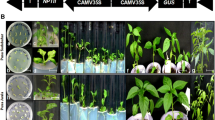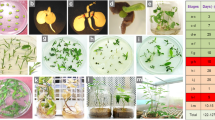Abstract
An efficient procedure for direct organogenesis and regeneration of hop (Humulus lupulus L.) was established. For the first time Agrobacterium-mediated genetic transformation of hop (cv. "Tettnanger") was achieved. Shoot internodes from in vitro cultures were identified as the most suitable type of explant for regeneration. Using this type of explant, a shoot-inducing medium was developed that supported direct organogenesis of approximately 50% of the explants. Plantlets were successfully rooted and transferred to the greenhouse. Overall, in less than 6 months hop cultures propagated in vitro were regenerated to plants in the greenhouse. Agrobacterium-mediated genetic transformation was performed with the reporter gene GUS (β-glucuronidase). The presence and function of transgenes in plants growing in the greenhouse was verified by PCR (polymerase chain reaction) and enzyme assay for GUS activity, respectively. We have obtained 21 transgenic plants from 1,440 explants initially transformed, yielding an overall transformation efficiency of 1.5%.




Similar content being viewed by others
Abbreviations
- BAP :
-
6-Benzylaminopurine
- GA 3 :
-
Gibberellic acid
- GUS :
-
β-Glucuronidase
- IAA :
-
Indole-3-acetic acid
- IBA :
-
Indole-3-butyric acid
- NAA :
-
α-Naphthaleneacetic acid
- nptII :
-
Neomycin phosphotransferase II
- PCR :
-
Polymerase chain reaction
- TDZ :
-
1-Phenyl-3-(1,2,3-thiadiazol-5-yl) urea (thidiazuron)
References
Adams AN (1975) Elimination of viruses from the hop (Humulus lupulus) by heat therapy and meristem culture. J Hortic Sci 50:151–160
Adams AN, Barbara DJ, Morton A, Darby P (1996) The experimental transmission of hop latent viroid and its elimination by low temperature treatment and meristem culture. Ann Appl Biol 128:37–44
Batista D, Sousa MJ, Pais MS (1996) Plant regeneration from stem and petiole-derived callus of Humulus lupulus L. (hop) clone Brangança and var. Brewers's Gold. In Vitro Cell Dev Biol Plant 32:37–41
Becker J (2000) Untersuchungen zur in vitro Regeneration und genetischen Transformation von Hopfen (Humulus lupulus L.). Dissertation, University of Kaiserslautern, Kaiserslautern, Germany
Connell SA, Heale JB (1986) Development of an in vitro selection system for novel sources of resistance to Verticililium wilt in hops. In: Withers L, Alderson PG (eds) Plant tissue culture and its agricultural applications. Butterworth, London, pp 451–459
Cleene M de, de Ley J (1976) The host range of crown gall. Bot Rev 42:389–466
Eppler A (1984) Hl-16, ein Kulturmedium zur Ein-Schritt-Regeneration von Hopfen-Pflanzen aus Meristemkulturen. Mitt Biol Bundesanst Land Forstwirtsch Berl Dahlem 223:173–174
Fleischer R (2003) Analyse der genetischen Variabilität im Tettnanger Hopfen mit Hilfe von AFLP-Fingerabdrücken. Dissertation, University of Hohenheim, Stuttgart, Germany
Fleischer R, Horlemann C, Kling C, Weber G (2003) AFLP fingerprinting in hop: analysis of the genetic variability of the Tettnang variety. Genet Resour Crop Evol (in press)
Franck A, Guilley H, Jonard G, Richards K, Hirth L (1980) Nucleotide sequence of cauliflower mosaic virus DNA. Cell 21:285–294
Gamborg OL, Miller RA, Ojima K (1968) Nutrient requirements of suspension cultures of soybean root cells. Exp Cell Res 50:151–158
Gippert R, Schmidt HE, Schmelzer K (1974) Einige Ergebnisse mit Spitzenmeristemkulturen bei Hopfen (Humulus lupulus L.). Arch Pflanzensch 10:7–13
Gurriaran MJ, Revilla MA, Tames RS (1999) Adventitious shoot regeneration in cultures of Humulus lupulus L. (Hop) cvs. Brewers Gold and Nugget. Plant Cell Rep 18:1007–1011
Heale JB, Legg T, Connell S (1989) Humulus lupulus L. (Hop): in vitro culture; attempted production of bitterning components and novel disease resistance. In: Bajaj YPS (ed) Biotechnology in agriculture and forestry. Springer, Berlin Heidelberg New York, pp 264–285
Hood EE, Helmer GL, Fraley RT, Chilton MD (1986) The hypervirulence of Agrobacterium tumefaciens A281 is encoded in a region of pTiBo542 outside of T-DNA. J Bacteriol 168:1291–1301
Huetteman CA, Preece JE (1993) Thidiazuron: a potent cytokinin for woody plant tissue culture. Plant Cell Tissue Organ Cult 33:105–119
Jefferson RA (1987) Assaying chimeric genes in plants: the GUS gene fusion system. Plant Mol Biol Rep 5:387–405
Jefferson RA, Burgess SM, Hirsh D (1986) Beta-glucuronidase from Escherichia coli as a gene-fusion marker. Proc Natl Acad Sci USA 83:8447–8451
Kubo S, Kagami Y, Nonaka K (1975) Culture of stem tip of the hop and elimination of virus symptoms. Rep Res Lab Kirin Brewing 18:55–62
Melchers LS, Thompson DV, Idler KB, Schilperoort RA, Hooykaas PJ (1986) Nucleotide sequence of the virulence gene virG of the Agrobacterium tumefaciens octopine Ti plasmid: significant homology between virG and the regulatory genes ompR, phoB and dye of E. coli. Nucleic Acids Res 14:9933–9942
Motegi T (1976) Induction of redifferentiated plants from hop leaf callus culture. Proc Crop Sci Soc Jpn 45:175–176
Motegi T (1979) Differentiation of shoots from hop stem callus culture. Kyoyubo Kenkyu Neupo Iwate Ika Daigaku 14:15–17
Murashige T, Skoog F (1962) A revised medium for rapid growth and bioassays with tobacco tissue cultures. Physiol Plant 15:473–497
Murthy BNS, Murch SJ, Saxena PK (1998) Thidiazuron: a potent regulator of in vitro plant morphogenesis. In Vitro Cell Dev Biol Plant 34:267–275
Oriniaková P, Matoušek J (1996) Viroid infection of hop (Humulus lupulus L.) mediated by Agrobacterium tumefaciens and conditions for hop transformation. Rostl Výr 52:233–239
Oriniaková P, Pavingerova D, Matousek J (1999) Methodical aspects of hop (Humulus lupulus L.) genetic transformation. Rostl Výr 45:219–227
Popov VI, Vysotskii VA, Tuktogulov IM (1986) Condition of cultivation of isolated hop apices for clonal micropropagation. Fiziol Rast 32:1191–1195
Pridmore RD (1987) New and versatile cloning vectors with kanamycin-resistance marker. Gene 56:309–312
Probasco G, Winslow S (1986) The use of shoot-tip culture to eliminate viruses from hop varieties grown in the United States. MBAA Tech Q 23:26–31
Rakouský S, Matoušek J (1994) Direct organogenesis in hop—a prerequisite for an application of A. tumefaciens-mediated transformation. Biol Plant 36:191–200
Samyn G, Welveart W (1983) Producing a "nuclear stock" of virus free hop plants. Fac Landbouw Rijksuniv Gent 48:877–881
Shaw CH, Carter GH, Watson MD, Shaw CH (1984) A functional map of the nopaline synthase promoter. Nucleic Acids Res 12:7831–7846
Šuštar-Vozlic J, Javornik B, Bohanec B (1999) Studies of Somaclonal Variation in Hop (Humulus lupulus L.). Phyton-Ann Rei Bota 39:283–287
Svoboda P (1988) Hormonal regulation of growth of isolated shoot tip meristems of hop (Humulus lupulus L.) in in vitro culture. Rostl Výr 34:713–716
Svoboda P (1991) Clonal propagation of hop in vitro. Rostl Výr 37:643–648
Svoboda P (1992) Hop explantate cultures. Rostl Výr 38:107–112
Vine SJ, Jones OP (1969) The culture of shoot tips of hop (Humulus lululus L.) to eliminate viruses. J Hortic Sci 44:281–284
Wetmore RH, Sorokin S (1955) On the differentiation of xylem. J Arnold Arbor 36:305–3170
Acknowledgements
This work was funded by "Ministerium Ländlicher Raum, Baden-Württemberg" and "Hopfenpflanzerverband Tettnang e.V.", whose support is gratefully acknowledged. Also we would like to thank Ute Born and Monika Stanke for their excellent technical assistance.
Author information
Authors and Affiliations
Corresponding author
Additional information
Communicated by H. Lörz
Rights and permissions
About this article
Cite this article
Horlemann, C., Schwekendiek, A., Höhnle, M. et al. Regeneration and Agrobacterium-mediated transformation of hop (Humulus lupulus L.). Plant Cell Rep 22, 210–217 (2003). https://doi.org/10.1007/s00299-003-0676-8
Received:
Revised:
Accepted:
Published:
Issue Date:
DOI: https://doi.org/10.1007/s00299-003-0676-8




